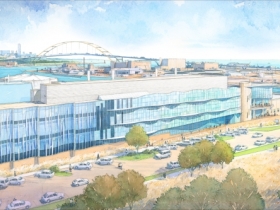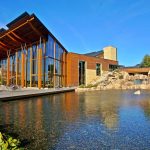The $74 Million Gamble
Can Milwaukee become a world water hub? It’s betting $74 million it can.
The Milwaukee Water Council’s mission statement makes its ambition clear: to establish this city not just as the Great Lakes leader or even the nation’s leader, but as “the global capital for fresh water research and education.”
Currently, the three global powerhouses in water research are Singapore, Israel and Netherlands. “Singapore and Israel have their own army. We don’t have that,” says Dean Amhaus, the water council’s executive director. Amhaus is joking, but in truth there is a grandiose feel to the proclamations and predictions regarding the city’s potential as a water technology leader.
Badger Meter CEO Rich Meeusen has in the past declared that “Milwaukee has a greater concentration of water technologies than any place on earth,” which is a bit of a stretch. David Garman, Dean of the recently created UW-Milwaukee School of Freshwater Science, has declared that Milwaukee can become “the Singapore of the Great Lakes.”
But as a story for Milwaukee Magazine by Barbara Miner found, White never publicly released any such list. A counter-study by UWM professor Marc Levine of the Center for Economic Development found there really more like 7,500 workers in the water industry here. Milwaukee, he found, ranks 7th nationally in plants and offices maintained by top 40 global water companies and 19th in water technology patents.
On the academic side, the UWM Great Lakes Water Institute is the largest academic freshwater research facility on the Great Lakes. But other universities in the nation have been beefing up their water research and curriculum.
But Meeusen, the driving force behind the water hub idea, has brushed off such carping as mere details. As Michael Horne recently reported for Urban Milwaukee, Meeusen conceded that other cities have plans similar to Milwaukee’s, but “I want to be so far ahead that I don’t care what they are doing.”
The idea is for the water council to work closely with the new UWM school, connecting water technology companies with university research, but the two groups ended up building separate headquarters. The water council is spending $21 million to renovate a 106-year-old building at 223 W. Pittsburgh (whose name will be changed to Freshwater Way). And the School of Freshwater Sciences will be spending $53 million to create a 100,000 square foot expansion of the existing UWM Great Lakes Water Institute at 600 E. Greenfield on the lakefront. The building will be a marine, freshwater and atmospheric research laboratory, with state-of-the-art labs for researchers and students, classrooms and quarantine facilities for aquatic organisms from the Great Lakes.
Some critics have questioned why two buildings instead of one, but there were some compelling reasons for this. The UWM facility needs to be on the lake, so research vessels have easy access to the water. But because of the public trust doctrine, that building could not have provided space for private companies. Which is what the water council’s headquarters will do. Moreover, Amhaus notes, “We can get in an existing building faster and cheaper.”
The group secured historic tax credits to help pay for the renovation of the seven story, 98,000 square foot building built in 1906. Badger Meter and A. O. Smith will have offices there, but Amhaus notes that UWM will have an entire floor in his building, which should enhance collaboration between business and academia. Besides, he notes, the lakefront headquarters for the UWM school is just three minutes away. “If things are done right three minutes apart actually gets closer and closer,” he says.
The renovation is expected to be finished by next summer while the UWM facility will take until at least the end of 2013.
In the meantime, there has been other progress for the water hub project. A proposal for a shared research by UWM, Marquette University and regional water-related companies won a $675,000 National Science Foundation Grant. UWM has created a new Center for Water Policy, with the help of a $2.6 million gift from Lynde Uihlein. And UWM seemed to score a coup in landing Garman as the first dean of its School of Freshwater Sciences.
Garman, who previously ran a water technology incubator in Australia, has a strong background in starting new water tech companies, and says the key to this is developing linkages between companies and universities. He predicts that in five years time the UWM school he runs will turn out 50 to 100 master’s and Ph.D graduates.
Questions About the Contractor
UMM’s lakefront building will be constructed by Janesville-based J.P. Cullen & Sons, which won a public bidding process. The company has done many projects for both UW-Milwaukee and UW-Madison, but it recently ran into controversy over its role in the exterior repairs for Milwaukee’s City Hall.
Repairs to the building’s terra cotta details are falling apart and the city now estimates a total price tag of $9 million to $15 million to repair the repairs. J.P. Cullen is one of several defendants in the suit, but a subcontractor hired by the company may ultimately be found responsible. Larry Rocole, vice-president of the Milwaukee office for J.P. Cullen, says “we’re cooperating (with the investigation). I think that at the end of the day JP Cullen may not be found at fault.”
Rocole says a key challenge in the building’s design was to make sure the temperatures stay constant for the aquariums; otherwise the fish can be harmed. The new facility’s price tag includes building a connection to We Energies’ underground steam tunnels, as steam heat is more reliable and better able to maintain a constant temperature.
The Amhaus Switcheroo
The 2010 federal tax form for the Milwaukee Water Council shows that it was making payments to the non-profit Spirit of Milwaukee for the services of Dean Amhaus, who previously served as Spirit’s executive director. In essence, Spirit of Milwaukee was loaning out Amhaus. “Dean worked hard to help create the water council,” says Gary Grunau, board chair of Spirit of Milwaukee.
In fact, he did almost all of his work for the water council in 2010, which paid Spirit $121,552 that year for Amhaus’ services, while Spirit paid him just over $18,000. In the process, it seems, Amhaus created a new job for himself as the water council’s executive director. Its annual budget for 2010 was $562,893. You can expect that to grow.
Murphy's Law
-
Is Legislature Biased Against Working Class?
 Apr 4th, 2024 by Bruce Murphy
Apr 4th, 2024 by Bruce Murphy
-
Associated Press Will Decline in Wisconsin
 Mar 27th, 2024 by Bruce Murphy
Mar 27th, 2024 by Bruce Murphy
-
City Attorney Race Is Vitally Important
 Mar 25th, 2024 by Bruce Murphy
Mar 25th, 2024 by Bruce Murphy



















Sometimes you have to wonder what are they actually researching. One would figure that 100’s of Universities and corporations should know almost everything about water after already conducting research the past 100 years or so. What more is there? Better pumping techniques? Better filtration? Understanding fish and ecosystems? They could just go to a bookstore and comb through the multitude of material that’s already available or even ask a fisherman. I just find it perplexing that 10’s of millions of dollars has to be spent on the buildings alone. And not to forget the millions for their annual budgets. Mankind has been on this planet for millennia and has consumed freshwater for just as long… but we still need to research the effects of it.
Frank,
I think all your questiosn can be answered on this page:
http://www4.uwm.edu/freshwater/research/
Seriously? That rational would be like saying…ah well. People having cancer and we’ve been researching it for decades and decades…what more is there to know?
You’re exactly right, better, cheaper filtration systems, better ways to combat invasive species, better ways to combat pollution and destructive algae…I am in no way very familiar with freshwater sciences and even I know there is an insane amount that is still to be discovered with just these few topics.
Btw, ask a fisherman??? I’ll make sure next time I have a complex engineering problem I need explaining, I’ll just stop at the first construction site I see and ask the guy digging a hole.
I am currently studying chemistry in college, and over the summer I conducted environmental engineering research at Northwestern University with a professor who received her training in aquatic chemistry. This by no means makes me some kind of expert, but I can tell you that I’m pretty amazed by the cool things that happen in water and the ecosystems it creates, as well as the useful ways you can manipulate those ecosystems.
When I first heard about the water technology push that was being made in Milwaukee, I didn’t have a very strong science background, and I shared many of the same thoughts as you, Frank. But now, after just barely skimming the surface of the field of environmental science, I see that there are so many areas of water research, including heavy metal remediation, analyte extraction techniques, greener methods of organic synthesis, just to name a few, that are promising.
Some of the most amazing processes of Nature are accomplished because of the unique chemical properties of water. Until recently, we have been largely unable to reliably observe and measure biotic processes that involve water. This is why water research is so exciting! Frankly, I think we should be spending more money on it. As it stands, what we know about water compared to what will be discovered about it in the next fifty years or so is a mere drop in the ocean.
@ Jerad –
Go ahead and ask the “hole digger”… I’m sure he’ll give you a good answer. FYI – Commercial fishermen are cognizant of their working environment. It’s what they do for a living. Apparently you missed my point… Point being: We should already be aware of how water and ecosystems coincide. I wasn’t aware that this was an ancient Chinese secret that no one else was aware of.
Why don’t we spend the money researching the best use of water: Beer. than we might have somethng.
While I agree that it is a big gamble, I think it is kind of exciting that Milwaukee is trying to become one of the major water hubs in the world. It has been argued that water will become the oil of the 21st century. “There’s remarkably little we can do to shape productive conversation on water issues until we return to a simple truth we all learned as children: we share a single hydrosphere and are connected through the water cycle–each of us positioned quite literally downstream from the other. Water is the defining issue of the 21st century–our century. As we work to better understand how it connects us all, I believe we will realize that we can be . . . that we must be, connected in working together for solutions as well.” –Alexandra Cousteau, Global Water Advocate and Founder of Blue Legacy. You can google Blue Legacy to learn more.
“By next year, 36 states are expected to have water shortages. Western rivers, and even some in the east, are overdrawn. Meanwhile, on the 40th anniversary of the Clean Water Act, 40 percent of U.S. waterways are not fit for fishing, swimming, or drinking.” –Trip Van Noppen. You can google Earthjustice to learn more.
There are going to be all sorts of political and economic fights about water in our future. We are getting a little trailer with the effort to bring water from Lake Michigan to Waukesha.
With regard to the 2 separate building sites being 3 minutes apart, I suggest that they set up a trolley line between the 2 sites with the trolley car being in the shape of a boat, modeled after the Dennis Sullivan if possible.
@Frank — “… I wasn’t aware that this was an ancient Chinese secret that no one else was aware of.”
And somehow, after a few really solid & informative responses to your first post, you’ve still managed to miss the point. Take an introductory, college-level general chemistry course. You’ll learn why water is understood in academics to be “the universal solvent.” Its properties are unique given its chAemical composition, and quite unlike the properties one might intuitively attribute to it based on the laws explaining chemical bonds, polarity & electronegativity, and enthalpy. A basic understanding of these concepts lets one see why water is so unique, allowing for the types of reactions it can undergo.
Yes, we know a great deal about it. Its a long-understood compound that has been a key ingredient in chemical laboratories since the days of alchemy. But just as the other commenters noted, we have nowhere to go progress-wise but forward concerning the cleaning and filtration of water, storage and transport of water – for example, take the alarmingly astronomical price of sending water to space, tens of thousands of dollars per cubic meter – as well as the hot-button issue of pottable water shortages, which we’re experiencing in our very own metropolitan area. As someone else mentioned, it is predicted to become a far more valuable commodity in the coming decades as out population inefvitably increases and climate change threatens greater and greater numbers of people. Additionally, as mentioned already, maintaining healthy ecosystems and managing the influx of invasive species, from fish and mollusks to algae and microbial life, the most abundant lifeform by shear number and biomass on the planet.
I think this move by the University is brilliant, and I count myself as among the prospective future grad students here, once my BS in Microbiology is complete. Anyone who doubts the impact this schools and the research it conducts will have, or doubts the relevance or need for such an academic facility and research innitiatives, keep your eyes peeled and your ears open over the next couple decades, and watch as the practical and afforable managment, production and distribution of freshwater to both urban and rural areas of the world becomes increasingly important, and those of you who are naysayers will come to realize why the rest of us view this “gamble” as a sure thing, totally worth going all-in for. It’s a winning hand, I assure you 🙂
Whoops, forgot to add, this:
@Bill Sweeney — re: boat-shaped trolley connecting the two facilities.
LOL. I love it. I’m not sure if facetious or serious, but it would be funny, relevant, and totally practical if there’s enough demand and daily traffic between the two facilities. If anything, let’s get the streetcar up and running, and let’s extend a line or two southbound, with one line running from downtown to the private facility on Pittsburg (or Freshwater Way rather) down to the University facility on Greenfield, and then continuing further south to the airport and southern suburbs and/or westbound down Greenfield ave over and southwest down Forest Home or elsewhere. Just a thought…